Alaska might have taken the territory’s share of Fortymile caribou if the Yukon government did not open up a licensed harvest, according to an Environment Yukon spokesperson.
“This is because Alaska has concerns about the herd reaching carrying capacity … and would like to see the population stabilize by ensuring the harvest quota is taken,” said Megan Foreman, the department’s director of communication, in a written statement. “We share some of these concerns. Our position is that opening harvest now is a responsible wildlife management decision that will support long-term conservation of the herd.”
The Alaska Department of Fish and Game didn’t immediately return a request for comment.
Rob Florkiewicz, harvest coordinator with Environment Yukon, said the Yukon and Alaska have been working collaboratively to manage the herd. It hasn’t been hunted for 25 years in the territory.
Roberta Joseph, chief of Tr’ondëk Hwëch’in, told the News last week that the First Nation was cut out of the decision, calling the move “unilateral.”
“(The) Yukon government shouldn’t let Alaska dictate their management on this side of the border,” she said in a written statement on Jan. 9.
Tr’ondëk Hwëch’in has been working on a draft management plan with the Yukon government and others that would determine where and how many caribou can be hunted. Joseph suggested that this should have been finished first.
“What is important is that the government and ourselves need to agree on where the hunts are gonna take place, the dates and the numbers that are gonna be issued,” she said last week. “That needs to be part of the plan in order to initiate the regulations.
“Tr’ondëk Hwëch’in has made a huge sacrifice on the Fortymile caribou,” said Joseph, noting that citizens are still in “conservation mode.”
The hunt was recommended by the Yukon Fish and Wildlife Management Board and supported by the Dawson District Renewable Resources Council, Foreman said.
In a letter sent to Joseph, management board chair John Burdek says he understands Tr’ondëk Hwëch’in’s concerns. He goes on to say that the “modest” hunt will ensure controlled growth of the herd.
Burdek said the decision was based off the herd’s health, among other things, that First Nation harvesting rights are being respected.
“This information clearly indicates the poor body condition of bull caribou in mid or late summer, females struggling to maintain body weight post calving, a reduction in three-year-old cows giving birth, and concerning mortality rate of calves.”
There’s no timeline for completing the draft management plan.
Foreman said that developing one is a “priority” and a mechanism that could put Tr’ondëk Hwëch’in’s concerns to rest.
Work on the plan has been ongoing since 2013, Foreman said. A new terms of reference was struck in 2017. Government representatives have met in the Dawson area on a bi-monthly basis in order to iron out the plan since then, she said.
“Developing a harvest management plan has been a key focus of this work but, in our view, opening a licensed harvest was not contingent on a completed plan. Government of Yukon representatives on the committee outlined to the intention to work towards holding a licensed harvest in 2020.
“The harvest management plan is intended to outline respective authorities and, through bilateral discussions, include specific harvest management actions to be taken by each party and guidance for their implementation.”
Foreman said the next meeting with Tr’ondëk Hwëch’in’ has not yet been scheduled.
The herd’s population has bounced back, now numbering roughly 84,000 animals. It hit a low of 6,500 in the 1970s.
There are 225 permits available for Yukoners. They are available by interval. Twenty-five are up for grabs during 10-day periods.
The herd is located along the Top of the World highway and the Fortymile area near Dawson City. The hunt ends on March 31.
Those wanting to hunt or camp on Tr’ondëk Hwëch’in settlement lands must receive the green light from the First Nation.
Contact Julien Gignac at julien.gignac@yukon-news.com
